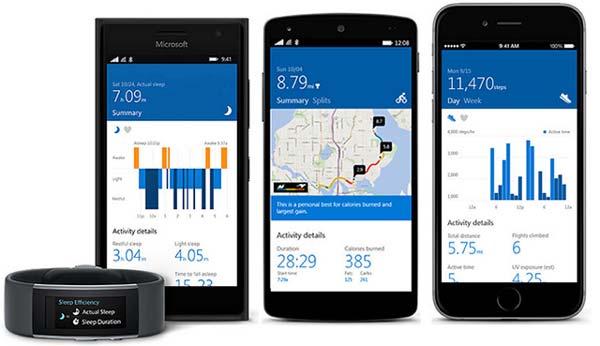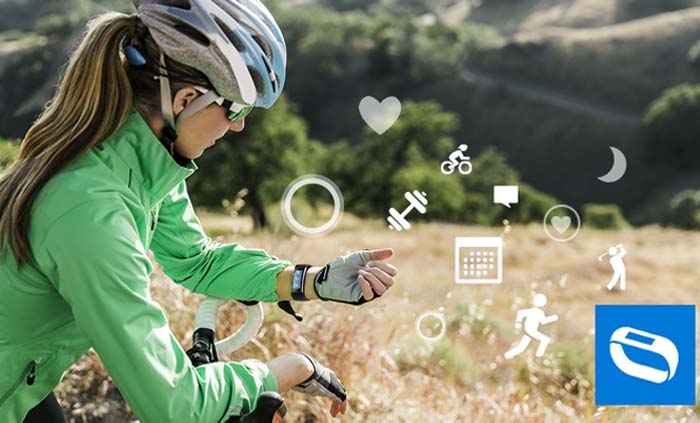Microsoft, using wearable technology has been in contact with cyclists from the just concluded Amgen Tour of California- an eight-day race that involved crossing the state- to provide analytical details on how the amount of workout affects the body. The objective is to combine what the band learns about your workouts and relate it to your recovery data. Eventually, allowing the device to perform an advisory role.
The cyclists wear the Microsoft Band 2 wearable technology to peak speed, track heart rate, and sleep patterns. The reports are documented in its blog where it also avails the distance and UV exposure.
Specifications
The Microsoft Band 2 has the following specification:
- A tri-axial accelerometer
- Optical heart-rate monitor
- GPS
- Microphone for Cortana
- Gyro
- Ambient light sensor nine sensors
- Capacitive sensor
- UV sensors enabling it to run gym workouts, circuits and most importantly cycling
It is the combination of all this information that gives the band the highest coaching potential. For instance, a weather tracker and UV sensor paired with the heart rate data, may one day inform you that you run best in the morning prompting you to change your exercising schedule to before the heat of the day.
How it works?
During exercises or bike mode or in a run, the band captures the heart rate once every second using an LED beam that is bounced at the arteries in your wrist. Like other wearables, the band is more accurate when recording mid-intensity workouts to higher workouts than a walk or warm up. It tracks the heartbeat throughout the day and periodically during sleep. With its ability to capture resting heart rate, the overall sense of health is assured.
Microsoft noted that cyclists who had few hours of restful sleep remained awake most of the time. It was also discovered that cyclists just like other athletes had a low heart rate while sleeping.
Band 2 App

The Microsoft Band 2 app has a screen that provides for a sequence of various activities. When selected, it displays any data that you desire. When cycling, it shows total speed, average speed, altitude, heart rate, and the time between two distinct screens. This Microsoft device is unique as it can track the route using the GPS sensors, and export that data to the training platform. Band 2 can efficiently record rides thanks to its altimeter. Unlike Fitbit and Apple Watch, Band 2 does not require a smartphone sensor to track movements. It is therefore used as a first cycling computer, despite the few limitations it has.
Battery life
The biggest barrier to Band 2 as a standalone computer is its inability to sustain three hours of consistent heart rate and GPS tracking. As such, it is best used as a backup to other wearable technology, short training programs or commutes. The band tracks the heart rate and speed and from these, the training effort, fitness effort, and VO2 max can be calculated.
For those who do not want to strap on the heart rate monitor, the band is the perfect alternative. The average and maximum heart rate fall within 3 or 4 beats of what is read on the heart rate monitor. The GPS loads quickly and as accurate as a Garmin; this is despite the fact that Microsoft maps being unpopular.
Heartrate Tracking
Details on heart rate are swiftly and automatically uploaded to Strava, though, this can quickly translate into useful tracking and training data. A buzz is produced between particular workout intervals making it essential for competitive outings.
The monitoring aspects around every cyclist are revelatory in nature. The band maintains a 24-hour log of your heart rate, connoting that you can see how your heart is holding week in week out after a rigorous training. Depending on your recovery rate, the revelation might be slow, medium or accelerated after the training period.
Sleep Tracking
![]()
Most cyclists do not attach a lot of importance on the need to have enough sleep. However, it is the recovery that makes a person better and healthy. Having a track of your heart rate at night is useful as it helps one to monitor the training cycles and to anticipate illnesses. Any bpm above 50, signals a warning to back off from training completely.
Data obtained while one is sleeping is important and goes beyond the standard measure of either a bad or good sleep. A quality sleep is devoid of either small or severe sleep interruptions at night or a groggy morning.
Software and Firmware
The Band 2 app has a very impressive hardware, the software on offer from Microsoft depicts some upgrading. The involvement of Microsoft in wearable technologies, and especially involving athletes and cyclists has been existing, the reason why clients are anticipating of an increased large-scale research and development funding that could eventually lead to an advanced and sophisticated understanding of the training. The language from the development team indicates that this might be in the process.
Regarding fitment and practical use, the Band 2 is all straightforward.
Size
Sizing is a factor worth considering. The Band 2 is split into three sizes, small, medium and large. Ensure that your choice of the band is right as it requires a tight fit to read the heart rate accurately.
You May Also Read: Why Apple Watch OS3 is the Ultimate Smart Watch?
Conclusion
With the current trends in technology, Band 2 will soon substitute cycling computer for those venturing into the sport, or those mounting the GPS to the stem. Alternatively, it is a great supplement to the tech employed by most riders. It is a vital asset to serious cyclists; it connotes 24 hours data from various training, health and fitness avenues. To many, this data gathering avenue will become more and more valuable, and impossible to stay without.


